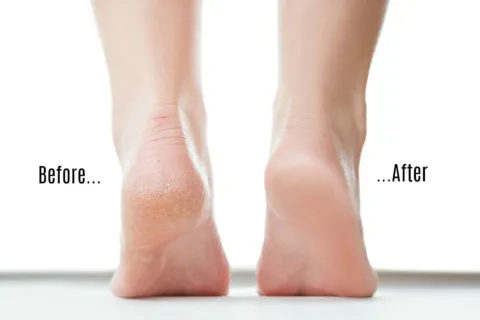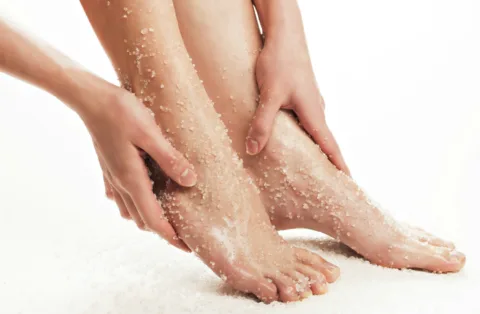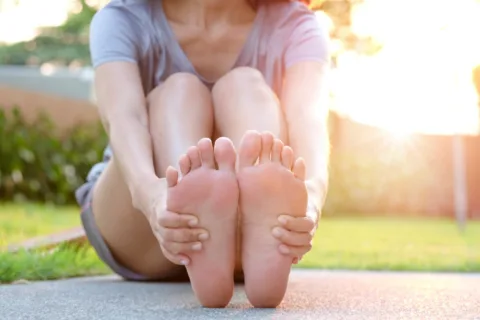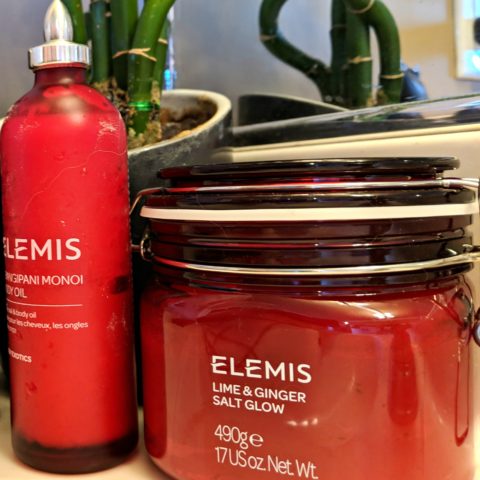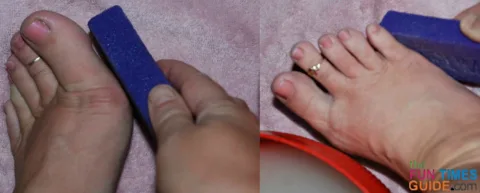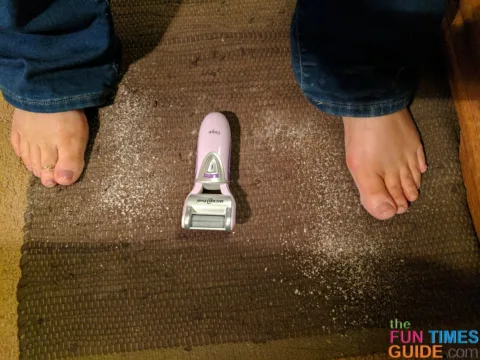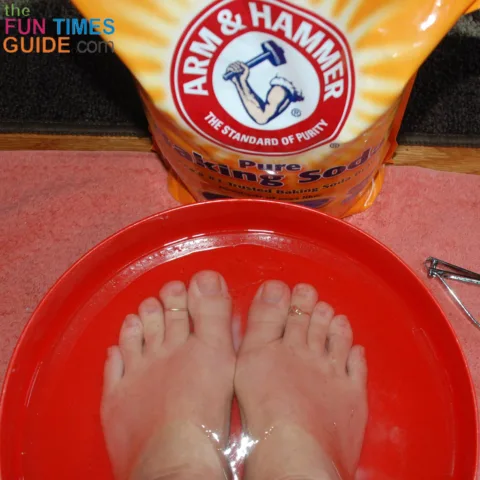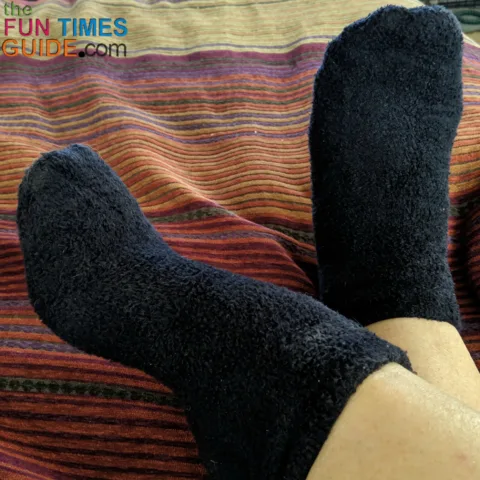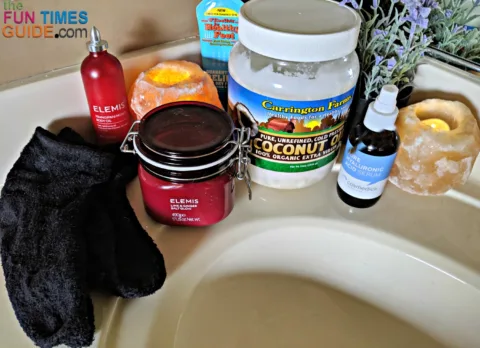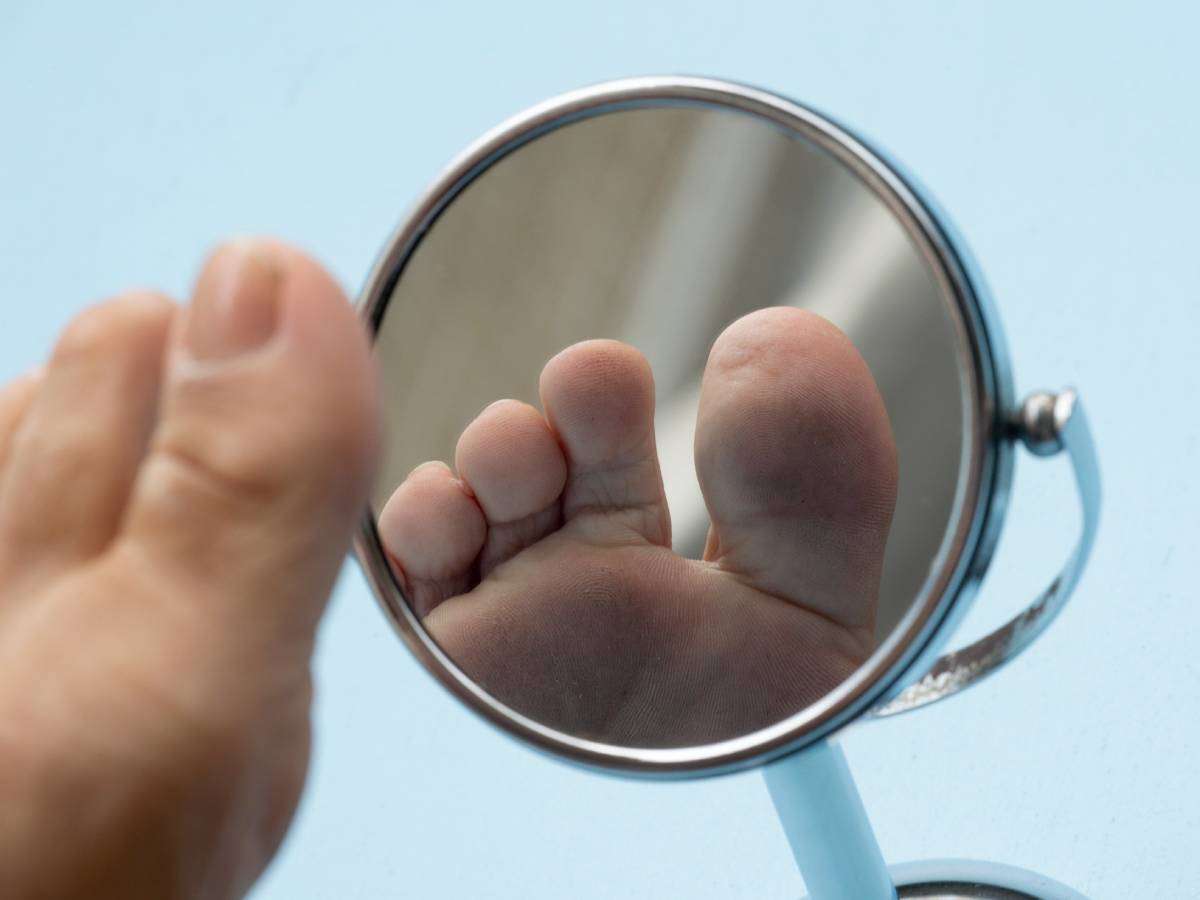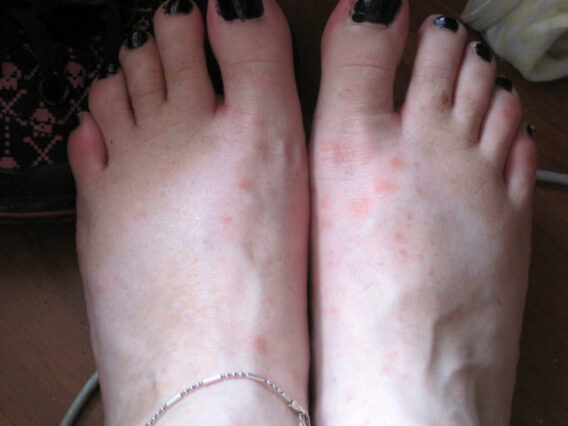I walk barefoot a lot, and my feet are extremely dry. (Yours too???)
This is why dry skin on your feet is so u-g-l-y:
The skin naturally sheds its outer layer over time. However, dry skin tends to get stuck, sloughing off more slowly. When this occurs, areas of the feet can become dry and cracked. As skin is often driest in areas where there is a lot of friction from shoes and walking, dry skin is sometimes layered on top of calluses. This can create a particularly unsightly appearance. Source
Okay… but I never knew you were supposed to exfoliate your feet with a cream that has little scrubbies in it. So I tried it, and it worked!
Did you know that you are supposed to gently exfoliate feet with a foot scrub instead of using a tool — like a callus remover, a pumice stone, or a foot file? (I didn’t until recently!)
They say that using a tool all the time on your feet is too abrasive and doesn’t allow fresh new (baby soft) skin to grow — instead, your old skin will just keep getting thicker. (Ugh… wish I knew this about a decade ago!)
So if you keep using a pumice stone to soften your feet all the time (like I did for years), your feet will always feel rough and dry.
Mind. Blown. That explains why my feet were so difficult to get back into good shape!
When the heels are cracked and peeling, it means that the skin barrier is disrupted — so the skin loses hydration, becomes inflamed, and is at an increased risk of developing infections. Good skin care can help minimize this or prevent it from developing in some cases … The technical name for cracking heels and feet is called keratoderma. It’s telltale sign is a thickening of the skin (typically on the soles). Source
So… all it takes is a simple exfoliating foot scrub to slough off the dead skin that builds up on the bottoms of your feet, as seen here:
I also learned that your choice of foot moisturizer makes a difference, as well.
If you have dry feet and cracked heels like I did — for years — then you’re definitely going to appreciate these tips I’ve learned for having softer, smoother feet.
First, Let’s Talk About Exfoliating Feet…
It wasn’t until I started exfoliating my feet that I finally got smooth feet and heels that lasted — we’re talking weeks at a time!
I was on a cruise when I learned this little tip about exfoliating feet.
I was getting a pedicure onboard the ship, and the Esthetician mentioned how dry and rough my feet were. (Eek… that’s embarrassing!)
She said all I needed for smoother feet was some exfoliation on a regular basis — followed by using a body oil as a moisturizer on my feet.
It sounded simple enough. She said you don’t have to buy a specific foot scrub or foot exfoliator — because they all work pretty much the same as a regular exfoliating scrub that you use on the rest of your body… and face.
It is extremely important to make sure that the skin on your feet is exfoliated because they can get dry and cracked,” says Mona Gohara, MD, a Danbury, Connecticut board-certified dermatologist. “Using AHA and urea are my favorite.” So that means yes, you can use your go-to chemical exfoliant on your peds. It works the same slough-off-that-dead-skin magic, which results in smoother, cuter feet. Source
For my first attempt at a DIY foot scrub at home, I bought the 2 products that the Esthetician happened to be selling in her Spa: ELEMIS Salt Scrub (for exfoliating) and ELEMIS Body Oil (for moisturizing). I bought them on Amazon, rather than in the Spa though.
TIP: To make your homemade exfoliating scrub, combine 2 tablespoons of Sea Salt with 1 tablespoon of Baby Oil and 1 tablespoon of Lemon Juice. Or… mix equal parts of uncooked Oatmeal with Milk to make a paste. Or… mix 1/4 cup of Epsom Salt with 1 teaspoon of Olive Oil.
Oh, and I learned another valuable lesson: you don’t need a pumice stone to remove the dry, rough skin from your heels and the bottoms of your feet…
Don’t Scrub With A Pumice Stone Or Foot File!
It’s no secret that I’ve been using a pumice stone religiously (like weekly… for many many years in a row).
That pumice stone and a couple of foot-soaking pedicures a year at the local salon (where they thoroughly soak your feet and scrub them — or file the rough spots with a tool that looks like a cheese grater!) were the only ways that I removed rough skin from the bottoms of my feet for the past decade… or more.
Add to that the fact that I tend to walk barefoot far more often than I wear socks or slippers inside the house (or shoes when I’m walking outside in my driveway or backyard) — and I clearly have not done my feet any favors through the years.
Of course, I thought I was doing the right thing by scrubbing the rough skin off the bottoms of my feet on a regular basis with a pumice stone — but boy was I wrong!
Remember, using an abrasive tool on your feet doesn’t allow fresh new (baby soft) skin to grow. Instead, your old skin will just keep getting thicker… and rougher. So if you keep using a pumice stone, a foot file, or even my favorite luxury tool — the Emjoi Micro-Pedi Callus Remover all the time (like I did for years), then your feet will always feel rough and dry. These types of foot tools are hurting, not helping, your dry cracked feet and heels.
NOTE: My ah-ha moment finally came when I saw the girl on QVC demonstrating how well the Emjoi Micro-Pedi works — time after time, beauty show after beauty show. (Yes, I used to watch QVC religiously.) And I got to wondering, “How come her heels are always so dry and flaky, yet she uses the Micro-Pedi tool all the time?!” The answer: Using anything abrasive on your feet makes the skin grow thicker… all the while doing nothing to hydrate or moisturize your feet. So your feet will continue to be dry and flaky — even though they’ll feel dramatically smoother at first.
So after hearing glowing reviews about using a foot scrub to exfoliate feet — instead of a foot tool — I’ve stopped using my favorite purple pumice stone to “saw” the rough skin off the bottoms of my feet.
Now, I only use the pumice stone (wet… and in a soft, circular motion) to gently remove the gritty scrub residue from my feet each time that I soak and exfoliate them. That way, I’m not actually rubbing skin off anymore with the pumice stone — I’m letting the little scrubbies that are in the exfoliator do all the work sloughing off the rough skin from my feet in a much gentler manner.
Unfortunately, it takes some patience and routine soaking & exfoliating before you’ll really see results and feel the baby soft skin on the bottoms of your feet. That’s because the rough skin doesn’t scrub off as drastically with an exfoliating foot scrub as it does when you’re using a pumice stone (or a foot file).
I’ll be honest… at first, I felt like I was just wasting my time — because removing the rough skin on my heels and calluses with a pumice stone always got immediate results! But I waited it out, stuck with using an exfoliating scrub instead, and I slowly grew to love my new gentle foot soaking & exfoliating routine.
How To Enjoy A Luxurious Foot Soak At Home
Here’s how I make a foot bath in the comfort of my own home (at least once a week):
- Fill a large bowl or tub that fits both of your feet at the same time with water — just enough to cover the tops of your feet. (You could also buy a heated foot spa — that’s what I did, after using a large red bowl for years. The ArtNaturals foot spa is my favorite… and it’s one of the least expensive, too.)
- Add one of the following to the water:
– Some epsom salt (I like the Eucalyptus and Lavender scented one)
– A little bit of essential oil (like Neroli Oil which is great for dry feet… or this combination of Peppermint, Lavender, and Tea Tree Oil )
– An oatmeal bath treatment (which makes the water soft and soothes your feet)
– A few cups of milk (it contains lactic acid, a natural exfoliator that also nourishes your skin)
– Some baking soda (I buy it in 3lb bags because it’s deodorizing and soothing — and useful all around the house) - Soak your feet for at least 20 minutes — the longer the better.
- Remove one foot from the water, gently pat dry with a towel, vigorously rub an exfoliating scrub over your entire foot (especially the rough areas like heels, bunions, and calluses). Then, put that foot back into the water for just 1 second to remove most of the exfoliating scrub. Remove that same foot from the water and while your foot is still soaking wet, use a foot brush to remove all of the tiny particles remaining from the exfoliating scrub off your foot.
TIP: You could also use a pumice stone to do this. Just make sure the pumice stone is thoroughly wet, and work in small circles — so you only remove the top layer of skin (not the entire area of rough, dead skin). This will promote healthy cell turnover on the bottoms of your feet. - Put that foot back into the water, and repeat Step 4 on the other foot.
- Pat dry both feet and apply a moisturizing oil to your feet right away — while they’re damp.
- If your feet are really dry like mine, then rub a thick foot cream onto your feet before slipping them into a pair of cotton socks — which will enhance the moisturization process.
For what it’s worth, there’s something called a Listerine foot bath making the rounds on social media. It’s said to heal dry feet — specifically dry, cracked heels.
Promises that a Listerine foot soak will leave dry, cracked feet rejuvenated and smooth have been making their way around Pinterest. But will a Listerine foot soak work? Listerine will not treat any underlying disease, but it may leave the feet feeling smooth and rejuvenated. In this article, we explore what the benefits may be of using this brand of mouthwash to soak feet. Source
Now, Let’s Talk About The Best Moisturizer For Feet…
The more you walk around on dry, rough feet… the drier and rougher they become!
So there’s no doubt about it — you’ll need a serious moisturizer if you want baby soft feet. Most department store moisturizers aren’t thick enough (so they don’t penetrate deep enough) for extremely dry feet.
The facts:
- Dehydrated skin lacks water.
- Dry skin lacks oil.
- Your feet, just like the rest of your skin, need both — water for hydration and oil for moisturization.
Here’s what causes dry skin in the first place.
To moisturize your feet, the trick is to lock in water and then apply a thin, penetrating oil to keep them feeling soft and smooth year round.
As the skin on the feet is naturally dry (the soles of the feet do not have their own oil glands), it can sometimes be tricky to keep your feet hydrated. In fact, dry skin on the feet is a common problem. It usually occurs in areas where there’s lots of pressure or friction, such as between the toes, on the ball of the foot, and on the heel. If left untreated, dry skin can start to become uncomfortable as we walk. This can be alleviated by giving the skin the essential moisture it needs. Source
These are the products that I like to use on my feet immediately after each foot soak (at least once a week):
- I alternate between using hyaluronic acid and honey to hydrate my feet. (Yes, hyaluronic acid is actually affordable and easy to apply to your feet!)
- I alternate between using coconut oil and argan oil to moisturize my feet with a thin, lightweight oil moisturizer. (I actually use argan oil lots of different ways in my beauty regime.)
Since my feet are naturally super dry and I always want them to feel really soft, I moisturize them to the max!
- I also apply a thick cream moisturizer (not a lotion!) on my feet almost every night before slipping them into a pair of cotton socks — which speeds up the healing and intensifies the softness. I alternate between Healthy Feet foot cream and Surgeon’s Skin Secret. (By the way, here’s the difference between a cream and a lotion.)

